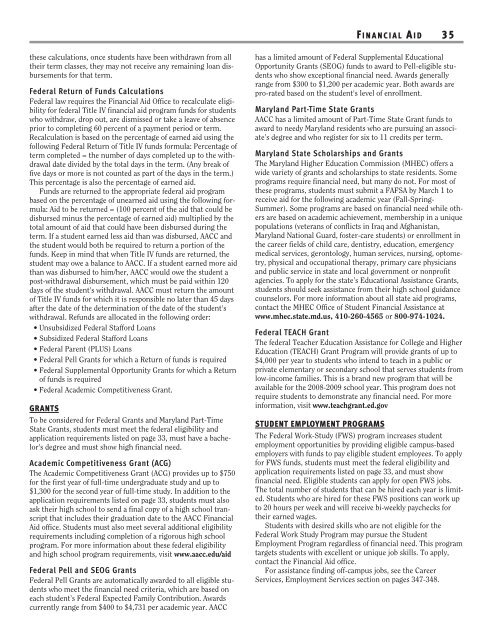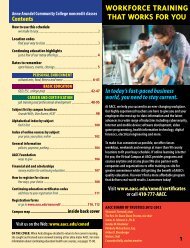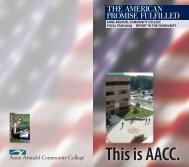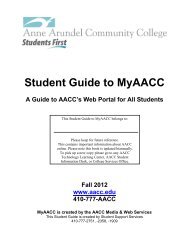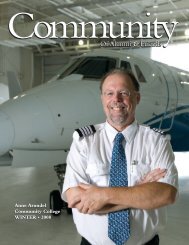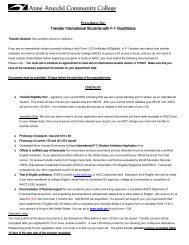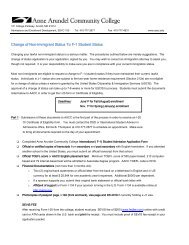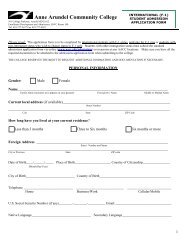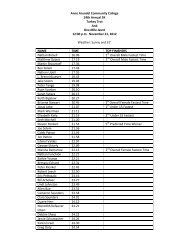101 College Parkway Arnold, Maryland 21012-1895 Internet ...
101 College Parkway Arnold, Maryland 21012-1895 Internet ...
101 College Parkway Arnold, Maryland 21012-1895 Internet ...
You also want an ePaper? Increase the reach of your titles
YUMPU automatically turns print PDFs into web optimized ePapers that Google loves.
these calculations, once students have been withdrawn from all<br />
their term classes, they may not receive any remaining loan disbursements<br />
for that term.<br />
Federal Return of Funds Calculations<br />
Federal law requires the Financial Aid Office to recalculate eligibility<br />
for federal Title IV financial aid program funds for students<br />
who withdraw, drop out, are dismissed or take a leave of absence<br />
prior to completing 60 percent of a payment period or term.<br />
Recalculation is based on the percentage of earned aid using the<br />
following Federal Return of Title IV funds formula: Percentage of<br />
term completed = the number of days completed up to the withdrawal<br />
date divided by the total days in the term. (Any break of<br />
five days or more is not counted as part of the days in the term.)<br />
This percentage is also the percentage of earned aid.<br />
Funds are returned to the appropriate federal aid program<br />
based on the percentage of unearned aid using the following formula:<br />
Aid to be returned = (100 percent of the aid that could be<br />
disbursed minus the percentage of earned aid) multiplied by the<br />
total amount of aid that could have been disbursed during the<br />
term. If a student earned less aid than was disbursed, AACC and<br />
the student would both be required to return a portion of the<br />
funds. Keep in mind that when Title IV funds are returned, the<br />
student may owe a balance to AACC. If a student earned more aid<br />
than was disbursed to him/her, AACC would owe the student a<br />
post-withdrawal disbursement, which must be paid within 120<br />
days of the student's withdrawal. AACC must return the amount<br />
of Title IV funds for which it is responsible no later than 45 days<br />
after the date of the determination of the date of the student's<br />
withdrawal. Refunds are allocated in the following order:<br />
• Unsubsidized Federal Stafford Loans<br />
• Subsidized Federal Stafford Loans<br />
• Federal Parent (PLUS) Loans<br />
• Federal Pell Grants for which a Return of funds is required<br />
• Federal Supplemental Opportunity Grants for which a Return<br />
of funds is required<br />
• Federal Academic Competitiveness Grant.<br />
GRANTS<br />
To be considered for Federal Grants and <strong>Maryland</strong> Part-Time<br />
State Grants, students must meet the federal eligibility and<br />
application requirements listed on page 33, must have a bachelor's<br />
degree and must show high financial need.<br />
Academic Competitiveness Grant (ACG)<br />
The Academic Competitiveness Grant (ACG) provides up to $750<br />
for the first year of full-time undergraduate study and up to<br />
$1,300 for the second year of full-time study. In addition to the<br />
application requirements listed on page 33, students must also<br />
ask their high school to send a final copy of a high school transcript<br />
that includes their graduation date to the AACC Financial<br />
Aid office. Students must also meet several additional eligibility<br />
requirements including completion of a rigorous high school<br />
program. For more information about these federal eligibility<br />
and high school program requirements, visit www.aacc.edu/aid<br />
Federal Pell and SEOG Grants<br />
Federal Pell Grants are automatically awarded to all eligible students<br />
who meet the financial need criteria, which are based on<br />
each student’s Federal Expected Family Contribution. Awards<br />
currently range from $400 to $4,731 per academic year. AACC<br />
F I N A N C I A L A I D 35<br />
has a limited amount of Federal Supplemental Educational<br />
Opportunity Grants (SEOG) funds to award to Pell-eligible students<br />
who show exceptional financial need. Awards generally<br />
range from $300 to $1,200 per academic year. Both awards are<br />
pro-rated based on the student's level of enrollment.<br />
<strong>Maryland</strong> Part-Time State Grants<br />
AACC has a limited amount of Part-Time State Grant funds to<br />
award to needy <strong>Maryland</strong> residents who are pursuing an associate’s<br />
degree and who register for six to 11 credits per term.<br />
<strong>Maryland</strong> State Scholarships and Grants<br />
The <strong>Maryland</strong> Higher Education Commission (MHEC) offers a<br />
wide variety of grants and scholarships to state residents. Some<br />
programs require financial need, but many do not. For most of<br />
these programs, students must submit a FAFSA by March 1 to<br />
receive aid for the following academic year (Fall-Spring-<br />
Summer). Some programs are based on financial need while others<br />
are based on academic achievement, membership in a unique<br />
populations (veterans of conflicts in Iraq and Afghanistan,<br />
<strong>Maryland</strong> National Guard, foster-care students) or enrollment in<br />
the career fields of child care, dentistry, education, emergency<br />
medical services, gerontology, human services, nursing, optometry,<br />
physical and occupational therapy, primary care physicians<br />
and public service in state and local government or nonprofit<br />
agencies. To apply for the state’s Educational Assistance Grants,<br />
students should seek assistance from their high school guidance<br />
counselors. For more information about all state aid programs,<br />
contact the MHEC Office of Student Financial Assistance at<br />
www.mhec.state.md.us, 410-260-4565 or 800-974-1024.<br />
Federal TEACH Grant<br />
The federal Teacher Education Assistance for <strong>College</strong> and Higher<br />
Education (TEACH) Grant Program will provide grants of up to<br />
$4,000 per year to students who intend to teach in a public or<br />
private elementary or secondary school that serves students from<br />
low-income families. This is a brand new program that will be<br />
available for the 2008-2009 school year. This program does not<br />
require students to demonstrate any financial need. For more<br />
information, visit www.teachgrant.ed.gov<br />
STUDENT EMPLOYMENT PROGRAMS<br />
The Federal Work-Study (FWS) program increases student<br />
employment opportunities by providing eligible campus-based<br />
employers with funds to pay eligible student employees. To apply<br />
for FWS funds, students must meet the federal eligibility and<br />
application requirements listed on page 33, and must show<br />
financial need. Eligible students can apply for open FWS jobs.<br />
The total number of students that can be hired each year is limited.<br />
Students who are hired for these FWS positions can work up<br />
to 20 hours per week and will receive bi-weekly paychecks for<br />
their earned wages.<br />
Students with desired skills who are not eligible for the<br />
Federal Work Study Program may pursue the Student<br />
Employment Program regardless of financial need. This program<br />
targets students with excellent or unique job skills. To apply,<br />
contact the Financial Aid office.<br />
For assistance finding off-campus jobs, see the Career<br />
Services, Employment Services section on pages 347-348.


